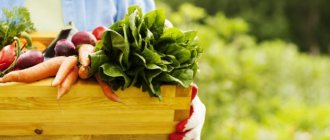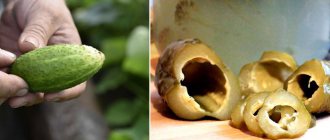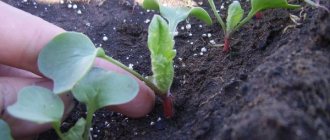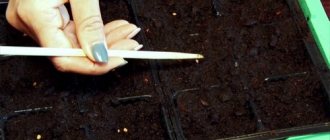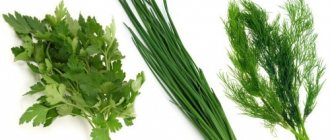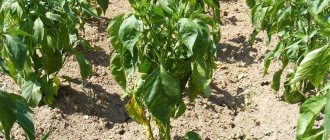Pumpkin is a dietary, tasty and healthy vegetable that is used in many dishes. The calorie content of 100 g of pumpkin is only 22 kcal, while the fruit contains many vitamins and minerals. Due to the beneficial properties of pumpkin, it is used to treat many diseases and in dietary nutrition. Growing this vegetable in a greenhouse or polycarbonate greenhouse does not happen so often, because pumpkin is a rather unpretentious plant and seedlings are more often grown in a greenhouse. Sometimes pumpkin is used as a seal and planted next to cucumbers and tomatoes. Planting seeds and caring for pumpkin have their own characteristics, and the use of herbicides should be limited.
Pumpkin Uchiki Kuri F1 early ripening with nutty taste, very productive
- Pumpkin Uchiki Kuri F1 is an early-ripening hybrid variety of Japanese origin with small teardrop-shaped fruits, intended for cultivation in various climatic zones.
- Crispy amber-honey pulp, spicy chestnut-nut flavor, Uchiki Kuri literally melts in your mouth, this is exactly the same pumpkin that turns into a delicious dish for the culinary fairy at any time of the day.
Rules for planting pumpkin Uchiki Kuri
- Features of growing Uchiki Kuri loves a lot of light and space, like any long-climbing melon crop. It is not recommended to plant more than 2 plants per square meter.
- Each lash produces up to 10 fruits with proper care. However, pumpkin does not require any special conditions. Follow the rules of crop rotation, fertilize the soil before planting - and you will get an excellent harvest.
Benefits of pumpkin Uchiki Kuri F1 Pumpkin can be stored for up to 5 months. Suitable for various culinary dishes, including making juices, cereals, casseroles, desserts. You can cook with the peel; as a result of heat treatment, it becomes soft and tender. Unusual taste with notes of roasted chestnut and a nutty aftertaste.
- Planting time: April - May
- Ripening time: August - September
- Features a wonderful nutty flavor!
- Distance between plants 60 x 100 cm
- Location sun
- The ripening period is early ripening from 85 to 90 days.
- Pumpkin weight up to 2 kg
Benefits of pumpkin
Pumpkin, which contains orange and yellow flesh, is richer in carotene. Of the mineral elements, pumpkin is rich in potassium, iron, calcium, and phosphorus. The sugar content of pumpkin depends on the weather: the hotter the summer and the sun's rays, the faster it ripens and becomes very sweet and tasty. The pulp contains sugar, fiber, proteins, carotene (as well as vitamins B1, B2, PP. C). Of the minerals, pumpkin is rich in potassium, calcium, phosphorus, iron and trace elements such as copper, cobalt, magnesium.
How to plant and grow pumpkin
The plant is heat-loving, light-loving, and produces high yields in fertile, well-warmed areas by the sun. In personal plots, pumpkins are often placed on the south side of walls or dense fences, where favorable conditions are created for its growth and development.
Rules for planting pumpkins
- Before sowing, the area intended for pumpkin must be well fertilized: per 1 m2 of bed, add 2 buckets of humus, half a bucket of sawdust, 1 glass of nitrophoska and 1 liter jar of wood ash. The plot is dug up to a depth of 50 cm. The bed is made 70 cm wide. The seeds are sown from May 10 to 15, always under the film, and on June 10–16 the film is removed. Holes for sowing are made along the bed, every 90 cm, 8–10 cm deep. Water with a solution (6 °C) of the growth regulator “Kornevin”: dilute 10 grams per 10 liters of water and water 0.5 liters per hole. Sow 2–3 seeds per hole. Sowing is carried out with dry seeds. After germination, one plant is removed.
- Seeds begin to germinate at a temperature of 15 °C; the optimal temperature for germination is 20–25 °C. Since pumpkin is a high-yielding plant with a large leaf mass, it needs high soil fertility (any type of soil is suitable if sufficient amounts of organic and mineral fertilizers are applied). Pumpkin is very responsive to organic fertilizers: manure humus, high-quality compost. And although pumpkin is drought-resistant, it responds well to watering in the first half of the growing season.
Description of the plant
Pumpkin is an annual liana-like plant with a fairly thin stem covered with short, hard fibers. Its leaves are large, dense, and blade-shaped. It is characterized by the presence of many tendrils on the stem, with the help of which in nature the plant can “climb” trees.
Most pumpkin varieties are vigorous climbing plants.
Most botanists consider South America to be the birthplace of pumpkins. But there is also a variety of it, common in Europe and Asia. The ancient Greeks, Romans and Chinese used bottle gourd to make flasks and other containers for storing drinks and food. In Russia, the culture has been known for quite a long time, approximately since the 16th century. It quickly gained popularity; peasants appreciated its unpretentiousness, high yield and keeping quality.
Pumpkin flowers are large and single. They are unisexual, so the plant needs the help of a gardener for pollination, especially if cultivated in a greenhouse.
Pumpkin flowers are unisexual; for pollination the plant will need the help of insects or a gardener
The fruits are pumpkins (or false berries) of different sizes and shapes. The hard rind can be yellow, orange, or green; the flesh is usually saffron. Breeders have also bred red, gray, brownish and variegated pumpkins.
Pumpkin weight varies from 200–300 g to 80–100 kg. “Natural” fruits contain approximately 25–30% edible pulp; in selectively bred varieties this figure reaches 80–90%. During storage, the taste of the pulp improves as the starch it contains is converted into glucose and sucrose.
Different varieties of pumpkins differ in shape and color.
Pumpkin grows faster than the vast majority of vines. Therefore, it needs moisture and nutrients. The more often it is watered and fertilized (especially with natural organic matter), the more abundant the harvest. This is especially true for decorative pumpkins.
Perhaps the only, but very significant drawback of pumpkin is its inability to tolerate low temperatures. Already at -1ºС, most plants will inevitably die. Even a short-term drop in temperature is dangerous for her. Therefore, gardeners in regions where return spring frosts are common should, if necessary, cover the bed with covering material or plastic film.
Benefits of pumpkin
The bright orange color of the pulp indicates the presence of a high concentration of carotenoids, in particular vitamin A. Pumpkin is also rich in vitamin D, which is vital for the proper growth and development of the child’s body. The pulp contains rare vitamins K and T. The first is necessary for hematopoiesis, the second - for normalizing metabolism. It helps the body digest and absorb heavy foods faster and prevents obesity. Among the microelements, one can note the presence of iron (more than in apples), copper, potassium, zinc, cobalt, calcium and phosphorus.
Pumpkin is also high in pectin and easily digestible fiber. Thanks to this, when consumed regularly, it helps to normalize the activity of the gastrointestinal tract and is useful for the prevention of liver and kidney diseases. Nutritionists recommend including it in the diet for hepatitis, cholecystitis, pyelonephritis, enterocolitis, even in the acute stage.
Pumpkin is a natural diuretic and laxative. In addition, it can be used as an antiemetic. It is often recommended for pregnant women and those who suffer from seasickness. You can also drink juice mixed with lemon to combat nausea.
Pumpkin juice, when consumed regularly, helps to cope with constipation; it is also an effective prevention of the development of inflammatory processes in the bladder and appendages. It helps remove excess fluid from the body, therefore it is indicated for hypertension, which is often accompanied by edema. And if you mix the juice with honey and drink 50–70 ml every evening, you can get rid of insomnia.
Pumpkin juice helps cope with attacks of nausea and normalize sleep
The only contraindication is individual intolerance. Pumpkin should be eaten with caution if you have gastritis or a stomach ulcer in the acute stage. In addition, if you consume it immoderately or drink it with cold water, you can cause bloating and colic. But this unpleasant effect can be easily neutralized if you add dill or its seeds to the pulp. And in eastern countries, cumin is used for a similar purpose.
Pumpkin is widely used in cooking. It is added fresh to salads. You can make soups, porridges, and casseroles from it. Pumpkin puree is a very healthy side dish for meat dishes. It helps to digest heavy foods better.
Pumpkin dishes are tasty and healthy
Video: health benefits of pumpkin
Rules for planting pumpkin seedlings and seeds in open ground
2 ways to grow pumpkin - seedlings and direct sowing of seeds in the ground
Growing pumpkin by sowing in the ground
- Dry seeds can be sown on May 15–20, germinated – on May 25–31. The seeds are planted to a depth of 2–3 cm. When growing pumpkins, it is very important to follow the sowing pattern (planting seedlings). Beginning gardeners often sow seeds too often, which subsequently leads to thickening of plants and reduced yields. When sowing, the distance between plants should be up to 1 m, and the vines should be directed in different directions.
- When preparing the soil, it is advisable to add half a bucket of manure humus and about 1 teaspoon of universal potassium humate fertilizer into each hole, thoroughly mixing it all with the soil.
- In hot and dry weather, pumpkin plants are watered generously. Carry out 2-3 liquid fertilizing with complex mineral and organic fertilizers, after which the soil is loosened. They weed until the rows close. If necessary, the tops of young shoots can be laid in the desired direction and pinned to the soil surface. In this case, the plants will occupy exactly the area that you allocate to them. Sprinkling moist soil between the nodes promotes the formation of additional roots, which enhances plant nutrition.
Growing pumpkin seedlings
- As a rule, the seedling method is used for growing late-ripening varieties. Seeds are sown a month before planting seedlings. Only potted seedlings are used (pot diameter 10–12 cm). It is necessary to take into account that pumpkin plants, even in seedlings, have rather large leaves, they need a lot of space, so the pots need to be periodically arranged.
- Seedlings are planted after the frosts have completely passed (in central Russia - in early June). 7–10 days before planting, the seedlings must be hardened off, taken out to the balcony, loggia, reducing watering, increasing lighting and ventilation.
- Unhardened seedlings planted in open ground lead to the death of young plants, since under bright sunlight they get severe burns and the leaves dry out, but they can be saved by covering the planted plants with covering material for about a week, and then removing them in the evening or in cloudy weather.
- In a summer cottage or garden plot, it is best to place pumpkins along the fences, so they do not disturb anyone.
Popular varieties
Pumpkin fruits of different varieties vary in color, shape, weight, taste, and ripening time.
Large pumpkin
Gardeners especially appreciate large-fruited varieties. Firstly, it is the sweetest pumpkin (the content of glucose and fructose in the pulp reaches 15%), and secondly, it is unpretentious and high-yielding. A dense, hard crust ensures transportability and good shelf life.
The best varieties of large-fruited pumpkin:
- Smile. The plant is bushy and quite compact. The length of the main vine is up to 1 m. It can also be grown to decorate the site. The growing season is 85 days (early variety). The fruits are spherical, smooth, weighing 0.7–1 kg. There can be up to seven of them on one plant. The rind is bright orange with thin whitish stripes. The flesh is the same tone, crispy, and has a pronounced melon aroma. The variety is high-yielding, relatively cold-resistant;
- Titanium. Belongs to the category of mid-late varieties. The plant is climbing, not suitable for a standard six hundred square meters. The weight of the fruit varies from 50 kg to 100 kg, so only one ovary is left on each lash. The rind and flesh are golden yellow. The variety is demanding on soil nutrition and does not tolerate waterlogging;
- Paris red. French mid-late variety. The growing season is 100–120 days. It is distinguished by an unusual shade of the crust - from orange-pink to dark scarlet. The weight of the pumpkin reaches 15–20 kg; its ribs seem to be divided into separate segments. The pulp is pale yellow, dense, but juicy;
- Therapeutic. An early ripening variety, excellent for dietary and baby food. The lashes are short. The crust is greyish, with brighter greenish veins arranged in a mesh pattern. The fruits are flattened, weighing 3–5 kg. The pulp is light orange. The plant survives short-term temperature drops to -2°C. Often suffers from fungal diseases (rot, anthracnose, powdery mildew);
- Yellow quintal. Medium ripening variety from Germany. The plant is very powerful, spreading, with long side branches. The average weight of a vegetable is 60–70 kg, individual specimens weigh 100 kg or even more. The rind is golden, the fruits are flattened, with clearly defined segments. The variety is distinguished by an increased concentration of carotene and glucose in the pulp; it is used in the food industry for the production of baby food. It is also often planted for its seeds;
- Bush gold. Early ripening variety. The main vine is short, the plant looks more like a bush. The fruits are flat-round, the division into segments is weakly expressed. The weight of the pumpkin is 2.8–3.7 kg, it greatly depends on the fertility of the substrate. The rind is yellow-orange, the flesh is bright yellow and crisp. The variety tolerates drought well;
- Crocus. Bush mid-season variety (pumpkins ripen in 108–112 days). The fruits are in the shape of an almost regular ball with implicit segments. Weight - about 4–5 kg. If the summer is good in terms of weather, and the plant is provided with proper care, this figure can reach 16–20 kg (according to the originator, even 36 kg). The rind is gray, the flesh is golden yellow, rough. It is valued for its ability to survive at temperatures of -1–2°C and for its high immunity to bacteriosis (but is often affected by powdery mildew). Unpretentious even compared to her “relatives”;
- Merchant's wife. Mid-season pumpkin. The plant is climbing. The average weight of a mature vegetable is 3–5 kg, but can reach 10–13 kg. The fruits are flattened, with pronounced segments. The rind is light orange, the pulp is saffron, with a high starch content, very dense;
- Azure. The variety is medium late; pumpkins take 100–125 days to ripen. The plant is powerful and climbing. The fruits are shaped like turnips, the rind is gray with a brownish tint. The division into segments is clearly expressed, the crust seems to be wrinkled. The pulp is bright orange, crispy, rough. The variety is suitable for dietary nutrition and is disease resistant. The weight of the fetus is about 4.5 kg.
Photo gallery: common varieties of large-fruited pumpkin
Pumpkin Smile is a compact plant that can be grown even at home
Titan pumpkin does not have outstanding taste; it is often grown for the sake of a record
Paris red pumpkin is easily identified by its pinkish or reddish rind.
Medicinal pumpkin pulp is recommended for dietary and baby food. Individual specimens of the Yellow quintal pumpkin fully justify the name. The more fertile the substrate, the larger the fruits of the Golden Bush pumpkin ripen.
Crocus pumpkin can withstand short-term exposure to freezing temperatures
Kupchikha pumpkin has a high starch content in its pulp
Pumpkin Azure has a large seed chamber
butternut squash
Butternut squash has a wonderful taste and a high concentration of vitamins, microelements and other substances necessary for the body in the pulp. But it is very demanding of heat, so in Russia it can only be grown in the southern regions with a subtropical climate or as seedlings in a greenhouse or under film. Butternut squash is easily distinguished from other varieties by its expanding, pentagonal stalk and yellowish-brown seeds.
Its most popular varieties:
- Golden pear. One of the new selections. The fruits have an interesting teardrop shape. The rind is bright orange, the flesh is slightly lighter, very juicy, with a pronounced nutty flavor. The average weight of a vegetable is 2 kg. The variety is early ripening, pumpkins ripen in about 90 days. Valued for its high resistance to diseases typical of the culture;
- Arabatskaya. The variety is extremely popular due to the fact that it rarely fails the gardener. Belongs to the late category, the fruits ripen in 115–125 days. The plant is climbing. The approximate weight of the pumpkin is 6.5 kg, individual specimens - up to 20 kg. It is elongated in shape (up to 60–80 cm), reminiscent of a mace. The rind is terracotta, the flesh is bright orange;
- New. Very similar to the previous variety, only the fruits are not as large (4–5 kg), and the growing season is 10–15 days longer. But it has very good keeping quality;
- Vitamin. A late-ripening variety, pumpkins ripen in 124–140 days. The fruits are broadly oval, with clearly visible (especially near the stalk) ribbing. As it ripens, the rind changes color from pink-orange to brown with a pinkish tint. The characteristic pattern is a “mesh” of thin green strokes and elongated beige-brown spots. The flesh is red-orange. The average weight of a vegetable is 4.5–7 kg;
- Hylea. A medium-ripening variety (fruits ripen in 100–110 days). Pumpkins vary in shape from almost round to zucchini-shaped. The terracotta-colored crust is covered with a bluish coating. The flesh is slightly darker, with a reddish undertone. Vegetable weight: 6–8 kg. Pumpkins can be stored for about a year without losing their presentation, benefits and taste of the pulp;
- Marina di Chioggia. Italian variety. The crust is white-green with a bluish or silver-gray tint, lumpy. The weight of the vegetable is 5–6 kg, some specimens weigh up to 10 kg. The pulp is golden, very dense, the seed chamber is small;
- Butternut. A variety from the late-ripening category, the plant is powerful, intensively branching. Fruits weigh about 1 kg or a little more. Pumpkins are shaped like pears. The color of the rind varies from pale orange to terracotta. The pulp is orange-golden, fibrous, very sweet, as if oily, with a pronounced nutty flavor. Can last up to six months in normal home conditions.
Photo gallery: the best varieties of butternut squash
Golden Pear pumpkin is one of the latest achievements of breeders
Arabat pumpkin rarely leaves a gardener without a harvest
Pumpkin Novinka is a little smaller than Arabat pumpkin, but otherwise very similar to it
Vitaminnaya pumpkin can easily be mistaken for a melon from a distance
The shape of the Hylea pumpkin fruit varies greatly, but this is the norm for the variety.
Pumpkin Marina di Chioggia is a time-tested Italian variety that has successfully taken root in Russia
Butternut pumpkin is extremely highly valued by gourmets for the taste of its pulp.
Gymnosperm (hard-bark) pumpkin
Hard-barked or gymnospermous pumpkin is most often grown for its seeds, which do not need to be peeled. Its pulp is not distinguished by its sweetness and juiciness, and the yield is also not very high. It is recommended to plant this pumpkin away from other varieties to avoid cross-pollination.
Most often, gardeners grow the following varieties:
- Bulgarian (or Lady's Nail). Bush plant. The vegetative period is about 100 days. The fruits are slightly flattened, without division into segments. The rind is yellowish-gray, the flesh is pale yellow. The average weight of a vegetable is 4–5 kg;
- Gribovskaya bush 189. One of the earliest varieties, the fruits ripen in 86–98 days. The plant is bushy, but at the same time quite powerful. Pumpkin weight is 2.3–4.8 kg. The crust is pale orange, covered with dark green spots and stripes. The shape is a cylinder that thickens towards the end. The pulp is golden, most often not too dense;
- Spaghetti (aka vermicelli). The variety is ultra-early (ripens in 62 days). The plant forms long vines. The average weight of the fetus is slightly less than 1 kg. The rind is yellowish-cream, and from a distance these pumpkins can easily be mistaken for melons. The pulp is beige, not juicy, with a slight vanilla aroma. When cooked, it breaks down into individual fibers, similar to pasta;
- Almond. For a hard-skinned pumpkin, it has very tasty flesh. The variety is mid-season (115–120 days). The plant forms extremely long vines. The fruits are almost round, orange, with greenish or brownish stripes, weighing approximately 3–5 kg;
- Danka Polka. Mid-early variety. The plant is medium-climbing. Pumpkins are spherical, without division into segments. The crust is orange-green, sometimes with whitish spots. The average weight of the fetus is 2–3.5 kg.
Photo gallery: varieties of hard-bark pumpkin
Bulgarian pumpkin is one of the most common varieties grown for seeds.
Bush pumpkin Gribovskaya 189 is one of the earliest varieties
Spaghetti pumpkin has a pulp that is very unusual in consistency; this property manifests itself only during heat treatment
The vines of the Almond pumpkin are very long
Danka Polka pumpkin has the shape of an almost regular ball
Shaping a pumpkin will increase the harvest
- Caring for plants consists, first of all, in their proper formation. To obtain up to 2 large fruits on each plant and accelerate their growth, plants are formed into 1, 2 or 3 stems.
- Formation of a plant into 1 stem. With this method of plant formation, 1 stem 1.5–2 m long is left. All side shoots and excess ovaries are removed. After the last fruit, 4–5 leaves are left, and the top (growth point) is pinched.
- Formation of a plant into 2 stems. With this method of formation, 2 fruits are left on the main stem, and on the side shoot both on the main stem and on the side shoots after the last fruit, 4–5 leaves are left, and the top (growth point) is pinched.
- Formation of a plant into 3 stems. With this method of formation, 1 fruit is left on the main stem and 2 side shoots. After each fruit, 4–5 leaves are left and the top is pinched. Excess shoots are removed. To speed up fruit loading, the remaining lashes can be pinned with a slingshot-shaped willow stick or wire and covered with a 7 cm thick layer of earth on top so that the lashes take root. Plywood, glass or other support is placed under each fruit.
Rules for planting pumpkins and care in the greenhouse
- Some gardeners grow pumpkin in a cucumber greenhouse and get high yields. In the corners of the cucumber greenhouse, holes are made for pumpkins with a depth of 50 and a diameter of 40 cm. The hole is filled with a nutritious soil mixture, for which you take 1 bucket of peat, humus, turf soil, and half a bucket of sawdust. Add 2 cups of wood ash and 2 tbsp to the soil mixture. spoons of nitrophoska, watered with a warm (40 ° C) solution of “Potassium Humate” for vegetable crops at the rate of 2 tbsp. spoons per 10 liters of water, watered at the rate of 3-5 liters per hole. 2 plants are planted in each hole or 2 seeds are sown.
- Dry seeds are sown in the center of the hole to a depth of 3–4 cm at a distance of 10–12 cm from each other. After germination, one or both plants are left.
- Planting seedlings or sowing pumpkin seeds in a greenhouse is carried out at the same time as cucumbers - from May 1 to May 20.
- When the pumpkin stem reaches 50–60 cm (approximately the second decade of June), it must be directed from the greenhouse to open ground. During flowering, additional pollination is required to fertilize the ovaries.
- In warm, sunny weather, they pick the male flower, tear off the yellow corolla so that the stamens are exposed, and touch them to the stigma of the female half-open flower. The entire procedure should be carried out with extreme caution.
Pests or diseases
Pumpkin can develop fungal diseases such as black mold, powdery mildew, rot, ascochyta blight and anthracnose.
Black mold appears as yellow-brown spots between the veins of the leaves, which become covered with a dark coating of fungal spores as the disease progresses. After the stains dry, holes form in their place. Young pumpkins shrivel and stop developing.
With ascochyta blight, large yellow-brown spots first form on the leaves, stems and shoot nodes, then light spots with a chlorotic edge, covered with black pycnidia containing the body of the pathogenic fungus. The pumpkin dries out and dies.
Powdery mildew is a real scourge of gardens and vegetable gardens, the symptoms of which look like a thick whitish coating, similar to spilled flour, which contains fungal spores. Leaves affected by powdery mildew dry out, fruits become deformed and stop developing. This disease is most active under conditions of sharp fluctuations in air humidity and temperature.
Anthracnose appears as large watery yellowish spots on the leaves. In wet weather, the veins of the leaves are covered with a pink coating. Gradually, pink spots spread over the leaves, petioles, stems and fruits, and by autumn the affected areas turn black. Anthracnose is most dangerous at high humidity.
White rot develops on all parts of the plant, causing damage to the root system, drying out of fruiting stems and reduced yield. The pumpkin turns yellow, turns brown, and becomes covered with a flaky coating of mold. Slime may appear on the stems. Gray rot appears as brown, blurry spots that quickly merge with each other and affect the entire plant. Wet bacterial rot can appear as a result of damage by slugs or podras to ovaries and young fruits in too dense plantings.
Among the insects, pumpkin is attacked by melon aphids, podura, or white springtails, wireworms and slugs.
Slugs eat the leaves of plants, sometimes leaving only a network of veins. There are especially many of them in the rainy seasons. In addition, they are able to live and harm plants for several years.
- Okra is magical in every way.
Melon aphids damage shoots, flowers, ovaries and the underside of leaves, causing them to curl and wrinkle.
Podurs are tiny white insects with a cylindrical body up to 2 mm long, feeding on seeds and underground parts of plants. Podura cause the greatest harm to plants in cold, damp weather.
Wireworms are the larvae of click beetles that gnaw at the root collar of young seedlings, which leads to the death of plants. Most of all, wireworms like to accumulate in damp lowlands.
Pumpkin processing
The fight against pumpkin diseases is carried out factually and preventively, which is undoubtedly preferable, since the disease is much easier to prevent than to cure. To protect pumpkin melon from fungal diseases, you need to observe crop rotation, comply with agrotechnical requirements, and take a responsible approach to each type of work, and especially to pre-sowing seed treatment. At the first signs of disease, spray the plants and area with one percent Bordeaux mixture or another fungicide. And try to make spring and autumn treatment of melons with Fitosporin mandatory - this will help you avoid many unpleasant surprises.
You will have to collect slugs with your hands or set up beer traps for them: place bowls of beer around the area and from time to time collect mollusks that crawled to the smell of it. Wireworms are also caught with bait by digging holes 50 cm deep in different places around the area, placing root vegetables cut into pieces there - carrots or beets - and covering the holes with boards, wooden boards or roofing felt. After a while, the traps check and destroy the wireworms gathered there. They fight durs by dusting the soil around the plants with wood ash. Aphids are destroyed with Phosfamide, Karbofos or a solution of 300 g of soap in 10 liters of water.
And yet, let us remind you that diseases and pests, as a rule, affect weak and unkempt plants, so observe crop rotation, fulfill agrotechnical requirements, conscientiously care for your plants, and you will not have to treat and save them.
Cleaning and storing pumpkins
- Pumpkins are harvested before frost sets in, as frozen fruits are poorly stored and begin to rot quickly. Cleaning is carried out in dry weather. For long-term storage, ripened fruits without cracks or dents are selected. Before putting them in a permanent storage place, they can be folded in a ventilated place protected from frost (loggia, veranda), transportation is carried out manually, very carefully.
- It is recommended to store fruits at a temperature of 7–12 °C. However, it is often impossible to create such conditions in a living room, so pumpkins are often stored in the coolest room, on the floor or shelves, where they are well preserved until the beginning of spring.
- Winter pumpkin varieties are stored on shelves or racks at a temperature of 6 to 12 °C. Its fruits must have their stalks preserved.
- To prevent temperature increases and dampness, storage facilities are ventilated. — Advice from Alexander Vladimirovich Ganichkin, Everything about the garden and vegetable garden.
Favorite pumpkin varieties and new items
Growing conditions
In order to grow not just a pumpkin, but tasty and juicy fruits on your plot of land, you need to comply with the conditions for cultivating this crop. First of all, you should adhere to the rules of crop rotation and plant plants of the pumpkin family (zucchini, cucumber, squash, pumpkin, watermelon) in their original place no earlier than after 4–5 years. Crops of the cruciferous and legume families are good predecessors. You should not plant melons nearby, so that if diseases appear, you will not be left without a harvest of all crops.
All pumpkin plants are demanding on lighting, the lack of which reduces the number of ovaries and increases the likelihood of diseases and pest attacks. Therefore, for pumpkins in the Urals, you should choose the warmest, well-lit and protected from the wind place, for example, behind the house or outbuildings. The site should be level and located away from upright growing crops.

